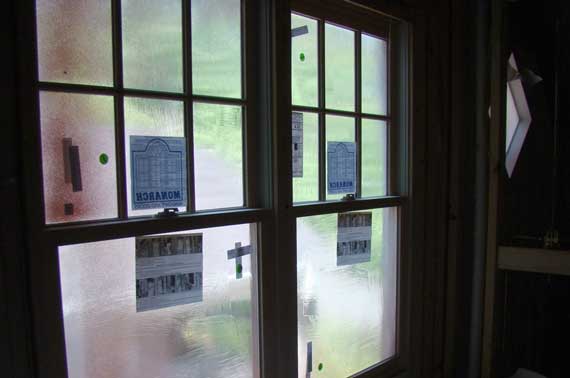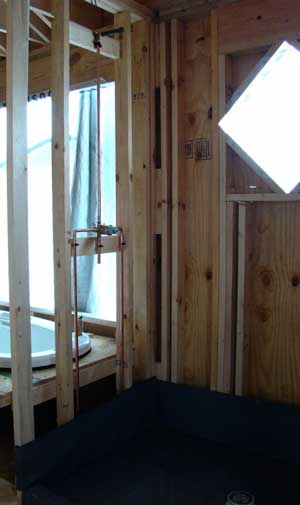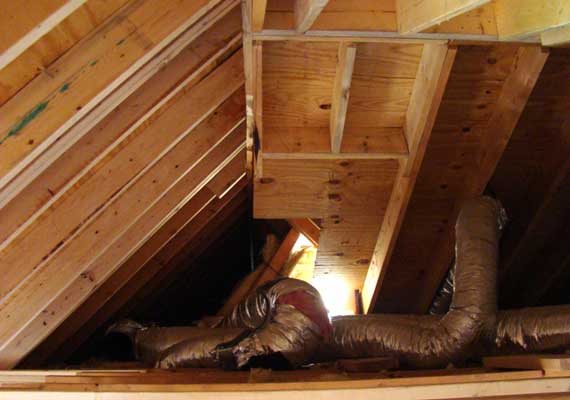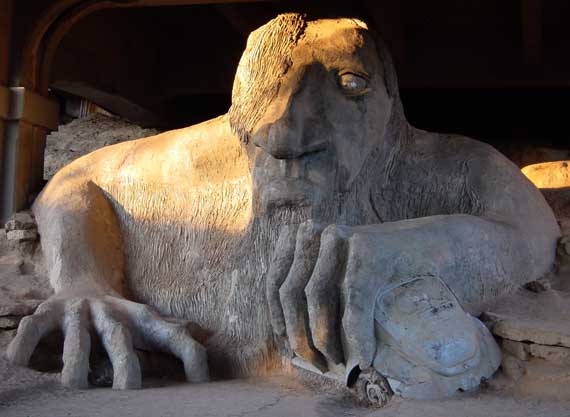Musings

This rebuilding project has been an adventure in learning about new building products.
The smeary stuff on the windows is the modern way to cope with the paint/glass interface. They put this stuff on, and it drys into a skin, then, after the paint is dried, make a clean cut along the glass/frame inteface and peel it away like skin two days after a bad sunburn.
If I’d only known about this magic stuff last summer when I was painting all those windows on the cottage! Well, actually, I have to finish them whenever we get back up there, so, voila! A new technique!*
* Reminder to self: ask The Guys what this most excellent Stuff is called!
UPDATE: it’s called Masking Liquid H2O, and costs something like $60/gallon, at least to our contractor, but it doesn’t take much, so maybe they sell half-pints for those of us with small jobs.
Posted at 4:08 PM |
2 Comments »

We knew we didn’t want to go back to fiberglass (or whatever they use now) batts for insulation, and after much on-line research, and chit-chatting amongst ourselves, we went with Soy Therm 50.
Soy Therm 50 spray-foam insulation is innovative, environmentally friendly and made with Soyol, USSC’s patented, soy-based polyol technology. It is an open-celled, water-blown, rigid polyurethane insulating foam that contains no ozone-depleting chemicals, VOCs, formaldehyde or asbestos. It expands upon application to fill all voids and cracks, and can save significantly on heating and cooling costs. At a density of 1/2 lb. per cu. ft., this is an excellent rigid foam insulation product for commercial and residential use.
…says the United Soybean Board web page….
And this is what it looks like part way through the process. You may be able to tell that the foam is applied against the outside of the house/roof, so everything—at least in new construction—inside of the outside walls would be “interior” relative to the insulation. And, bonus!, this means the house is much better sealed, especially against insects and other critter infestations. Even though we’re just able to have this on part of the upstairs, I think it’ll make a huge difference. Yes, we’re paying more, but I think we’ll be happier with our living situation (yea!, more storage! and more storage that’s insulated!).
Posted at 12:53 PM |
Comments Off on Soy Therm 50 Day

Archive photo.
Apparently those memorable footprint fireworks we saw as part of NBC’s coverage of the Opening Ceremonies were fake. There were fireworks, but we were seeing a computer-generated fantasy. I had it wrong.
UPDATE: cute little girl singing was miming; less-cute not-quite-so-little girl was singing in the wings.
Posted at 7:56 AM |
5 Comments »

Old-world techniques for drying newly-washed rugs persist in central Georgia.
Posted at 5:46 PM |
Comments Off on Rug handling

Today has been such a shock.
Yesterday this place was overrun with people. We had the regular framing and exterior guys (hammer, bang, thunk, rattle). For the first time, the plumbing crew joined us all, working from both downstairs and upstairs to reconstruct the plumbing for the master bath (partly in the ceiling of the dining room). They were mostly pretty quiet, except for when they knocked out and reinstalled pieces of framing; they also went up and downstairs frequently.*
Anyway, today we had a quick visit from the job-boss, and otherwise, no one. Apparently there’s a slim possibility that a city inspector will come by to check the plumbing, but everyone seems to think there’s a better chance the inspector will show on the next business day. After all, today’s Friday.
Ooops. Update. While I was massaging the photo, the bossman came back with the electrician for one of those here-here-and-here point-and-explain walk-throughs. Been and gone.
JCB’s even off to a lunch date, so it’s just me and the AC.
As to the photo, that’s our shower-to-be, with water standing in it for the inspection. There’s also water standing in the tub, but not visible from this view. I’m told all this is for the inspector. I am hoping mosquitos don’t find the puddles before they’re drained!
* Along with the reconstruction, there are oddities of code the plumbing has to address. One is some kind of a thingy that will make sure that the water going into a tub will never get hot enough to scald someone. I don’t think this applies to the sink or shower faucets, but I may not have been following that closely.
Posted at 12:39 PM |
Comments Off on Too quiet?

Under the roof above the stairwell—aren’t you glad you didn’t have to figure this mess out. NB: the lumber is straight despite curving effects from the lens.
We’re thinking about going with Icynene®* foam insulation between the joists up against the roof or exterior walls, which seals the heat out of all interior spaces.
Icynene® insulation and air barrier system creates an airtight seal to reduce random air leakage through the walls and limit the penetration of outdoor allergens and pollutants. 100% water-blown, Icynene improves the quality of the indoor air you breathe. It also reduces the number of indoor pollutants to help you breathe easier and is an environmentally-friendly soft foam insulation.
Anybody had any experience with this stuff? Watch the videos to see the foam expand!
* From the product spec sheet: “Icynene® spray formula is a 1/2 lb density free rise, open celled material.” FYI
Posted at 6:16 PM |
Comments Off on Decisions, decisions…

Archive photo of the Fremont Troll, a famous denizen of Seattle*.
Without a doubt, there are myriad kinds and types of tyrannies out there, many of them petty.
Tyranny of the day: software that seems to work in a certain way merely because it could be written that way, not because it’s wise, or even particularly useful—judged by this Ye Olde Average User.
You do not want to know more.
* …a city known for its software, both good and not-so-hot.
Posted at 3:30 PM |
1 Comment »

Look at the stored carbon in Kitch-iti-kipi, near Manistique, Michigan (2005 photo).
I think I have this right. Carbon levels in the air are affected by how much is emitted into the air. Reduce the amount entering the air (or reduce the amount already in the air), and we’re ahead.
So, one way to keep carbon out of the air: dead trees that don’t emit the carbon they hold. This article says by keeping dead trees emerged in water stores their carbon. Makes sense, they’re still trees, albeit waterlogged, and still holding their carbon.
What they don’t say is that if the trees are converted into building material or sculptures or whatever, it seems to me that stores carbon, too. It’s not decaying, so it’s not releasing its carbon….
Lesson? Cut more trees and keep the wood around.* Either submerged—or in your coffee table?
The difference, I guess, is that you can sell the fact that you’ve submerged the trees as carbon credits, but not that you’ve turned logs into lumber and into furniture, etc. Those you have to sell as material objects.
* Damage to the environment…priceless?
Posted at 9:21 AM |
Comments Off on Submerge that carbon

When the body shop saw the Prius after the tree hugged it, they said it’d take two-and-a-half weeks to fix it. Well, they had it four, and must have decided that they just wanted to divest themselves of it. I don’t even remember that the spoiler needed any work, but this is what the right end of it looked like when we picked it up (blobs on top of paint, holes through paint). Yeah, we need it, so we took it like this, with the assurance that they will fix it NEXT TIME. I’m sad!
Posted at 2:52 PM |
1 Comment »

Have you ever heard of Paul Otlet? I hadn’t. This NYTimes story by Alex Wright is fascinating.
Otlet (pronounced ot-LAY—French, right?) lived in the early 20th C and envisioned a global network (réseau) “that joined documents using symbolic links.” Of course, at his Mundaneum, begun in 1895 in Mons, Belgium, all he had were (clumsy) analog machines, which became bogged down in all the paper (index cards; Really!) he used to store the data. He toyed with this problem, eventually deciding “the ultimate answer involved scrapping paper altogether.” Sound familiar?
The Nazis came through Belgium in 1939, and destroyed many of the boxes of index cards. Poor Otlet died in 1944. Some cards survived, however, and a young grad student rediscovered them in 1968, and has lead a (long, slow) resurgence of interest in Otlet’s work.
Today, the new Mundaneum reveals tantalizing glimpses of a Web that might have been. Long rows of catalog drawers hold millions of Otlet’s index cards, pointing the way into a back-room archive brimming with books, posters, photos, newspaper clippings and all kinds of other artifacts. A team of full-time archivists have managed to catalog less than 10 percent of the collection.
The archive’s sheer sprawl reveals both the possibilities and the limits of Otlet’s original vision. Otlet envisioned a team of professional catalogers analyzing every piece of incoming information, a philosophy that runs counter to the bottom-up ethos of the Web.
And the picture? Oh, that’s from years and years ago when I was over in Athens working on my Master’s and an undergraduate in a journalism photography class recruited my friend Adam and me to do some jumping for one of her assignments, so she could get some action shots. À la covering a basketball game, I assume. We did so much jumping we got a bit silly.
Posted at 8:17 AM |
Comments Off on Grad students…









